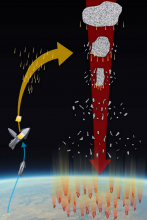Listen to today's episode of StarDate on the web the same day it airs in high-quality streaming audio without any extra ads or announcements. Choose a $8 one-month pass, or listen every day for a year for just $30.
You are here
Diamond Crater
The world’s biggest supply of diamonds was created in an instant. An asteroid a few miles in diameter slammed into northern Siberia 35 million years ago. In seconds, the heat and pressure transformed a layer of graphite into diamonds. The deposit could exceed all the other known diamond supplies on the entire planet.
The site is known as Popigai. It’s an impact crater more than 60 miles in diameter. Some of the crater has eroded away or been covered up, but much of it is still visible.
The impact that carved the crater melted hundreds of square miles of rock. And it blasted millions of tons of debris into the sky — some of which landed on other continents.
As the shockwave from the impact raced outward, it heated and squeezed the rocks. At a distance of about seven and a half miles from ground zero, temperatures and pressures were just right to make diamonds. That created a “shell” of diamond-rich rock.
Few if any of the diamonds are gem quality, though. They have a different structure, and most of them are no more than a couple of millimeters across. They’re especially hard, though, so they’d probably be good for industrial uses. That’s not likely to happen soon, though, because Popigai is remote — no towns or roads are anywhere close. And most industrial diamonds are made artificially. So the world’s richest diamond supply is likely to stay right where it is — at the site of a cosmic collision.
More about impact craters tomorrow.
Script by Damond Benningfield






